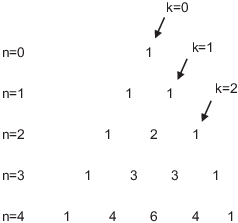If n and k are integers, ![]() , and
, and ![]() , then the binomial
coefficient
, then the binomial
coefficient ![]() (read n-choose-k) is defined
by
(read n-choose-k) is defined
by
![]()
Why "n-choose-k"? Suppose you have n different objects. How many ways are there of choosing k of them (without worrying about the order of choice)?
The first object can be chosen in n ways. Then there are ![]() objects left, so the second can be chosen in
objects left, so the second can be chosen in ![]() ways. Then there are
ways. Then there are ![]() objects left, so the third can be chosen in
objects left, so the third can be chosen in ![]() ways. And so on. At the
ways. And so on. At the ![]() choice, you have
choice, you have ![]() objects to choose from. So the number of
ways of choosing k objects in a particular order is
objects to choose from. So the number of
ways of choosing k objects in a particular order is
![]()
However, since I don't care about the order in which I choose the k
objects (only which k objects are chosen), I have to divide by the
number of different orders in which I could have chosen the k
objects. This is the number of permutations of k objects, which is
![]() . Hence, the number of ways of choosing k objects
from a set of n, without regard for order, is
. Hence, the number of ways of choosing k objects
from a set of n, without regard for order, is
![]()
Example. Compute ![]() and
and ![]() .
.
![]()
![]()
Proposition. ( Properties of binomial coefficients)
(a) ![]() .
.
(b) ![]() .
.
(c) ( Pascal's triangle) ![]() .
.
The last property has the following pictorial interpretation.

Make a triangle as shown by starting at the top and writing 1's down
the sides. Then fill in the middle of the triangle one row at a time,
by adding the elements diagonally above the new element. For example,
the leftmost 4 in the ![]() row was obtained this way:
row was obtained this way:
![]()
The formula above is simply an algebraic expression of this addition procedure.
Proof. You can check the formulas in (a) and (b) by writing out the binomial coefficients. Here's the computation for one part of (a):
![]()
And here's the computation for (b):
![]()
The proof of (c) is also a computation, though it's a little more involved:
![]()
![]()
Of course, binomial coefficients get their name because they're the coefficients in the expansion of a binomial:
![]()
Since the coefficients can be read off from Pascal's triangle, you can use the triangle to write down binomial expansions.
Example. Use Pascal's triangle to compute the
binomial expansion of ![]() .
.
Using the ![]() row in the triangle, I get
row in the triangle, I get
![]()
Example. Determine the coefficient of ![]() in the expansion of
in the expansion of ![]() .
.
The term containing ![]() is
is
![]()
(I cancelled the ![]() with the first 37 terms in
with the first 37 terms in ![]() , then cancelled the
, then cancelled the ![]() with
with ![]() and
and ![]() .) The coefficient is
.) The coefficient is ![]() , or
-36663215228190720 if you multiply it out.
, or
-36663215228190720 if you multiply it out.![]()
Example. Prove that
![]()
Some results involving binomial coefficients can be proven by
choosing an appropriate binomial expansion. In this case, I notice
that the "![]() " in the binomial coefficient
would come from expanding
" in the binomial coefficient
would come from expanding ![]() . But what
should I choose for x and y?
. But what
should I choose for x and y?
After some trial and error, I find that this works:
![]()
The binomial coefficient ![]() is the middle term in this sum --- but being the
middle term, it is also the largest term in the sum. Look at
Pascal's Triangle to convince yourself that this is true:
is the middle term in this sum --- but being the
middle term, it is also the largest term in the sum. Look at
Pascal's Triangle to convince yourself that this is true:

There are ![]() terms in the sum, and all of them
are less than
terms in the sum, and all of them
are less than ![]() . Thus,
. Thus,

Dividing both sides by ![]() , I get
, I get
![]()
Copyright 2019 by Bruce Ikenaga